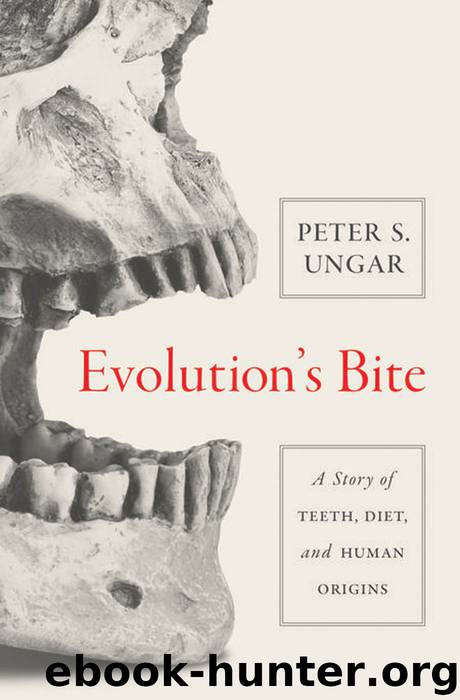Evolution's Bite: A Story of Teeth, Diet, and Human Origins by Peter S. Ungar

Author:Peter S. Ungar [Ungar, Peter S.]
Language: eng
Format: azw3
Publisher: Princeton University Press
Published: 2017-04-24T04:00:00+00:00
Working Out the Details
It was clear heading into the 1980s that microwear had promise, but that the devil was in the details. Alan Walker had moved once again, this time to work at Johns Hopkins, and enlisted the help of a couple of young anatomy instructors, Kathleen Gordon and Mark Teaford, to help work them out. Gordon focused on methods. What were the best settings for the SEM? How could scratches and pits be measured? Which tooth in the row, and which wear facets on that tooth, should be studied? All of these things made a difference and needed to be taken into account. Teaford began looking for differences in microwear between primate species. He made many trips, armed with his trusty dental impression material dispenser gun, to the Smithsonian Institution’s Museum of Natural History in nearby Washington, DC, to slather ever more specimens with tooth-molding goo.
Teaford was able to match the microwear pattern for individual species with diets documented by primatologists in the field. The Smithsonian had some gorilla skulls collected at Dian Fossey’s Karisoke Research Center in Rwanda (see chapter 2). Those wild-celery-eating gorillas, along with leaf-eating howling monkeys in the collection, had microwear surfaces covered in fine, parallel scratches. Brown capuchin monkeys and mangabey species known to eat hard foods—like nuts, palm fronds, and bark—had fewer scratches, but more large, deep pits. Fruit-eating orangutans and chimpanzees had intermediate microwear patterns. Those patterns made sense. If tough leaves and stems require shearing, abrasives in or on them should be dragged along the surfaces of opposing teeth as they slide past one another. That should result in scratches aligned in the direction of tooth movement. And if hard objects are crushed, pits should form as they are pressed between the enamel surfaces of upper and lower teeth. The microwear patterns were just as Teaford and Walker expected, given differences in diet and their understanding of how teeth break down foods with different properties.
Download
This site does not store any files on its server. We only index and link to content provided by other sites. Please contact the content providers to delete copyright contents if any and email us, we'll remove relevant links or contents immediately.
Sapiens: A Brief History of Humankind by Yuval Noah Harari(14171)
Sapiens by Yuval Noah Harari(5269)
Pale Blue Dot by Carl Sagan(4867)
Homo Deus: A Brief History of Tomorrow by Yuval Noah Harari(4781)
Livewired by David Eagleman(3626)
Origin Story: A Big History of Everything by David Christian(3594)
Brief Answers to the Big Questions by Stephen Hawking(3321)
Inferior by Angela Saini(3213)
Origin Story by David Christian(3121)
The Gene: An Intimate History by Siddhartha Mukherjee(3014)
Signature in the Cell: DNA and the Evidence for Intelligent Design by Stephen C. Meyer(3002)
The Evolution of Beauty by Richard O. Prum(2918)
Aliens by Jim Al-Khalili(2767)
How The Mind Works by Steven Pinker(2701)
A Short History of Nearly Everything by Bryson Bill(2585)
Sex at Dawn: The Prehistoric Origins of Modern Sexuality by Ryan Christopher(2444)
From Bacteria to Bach and Back by Daniel C. Dennett(2426)
Endless Forms Most Beautiful by Sean B. Carroll(2406)
Who We Are and How We Got Here by David Reich(2377)
